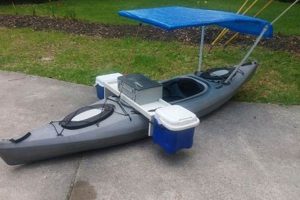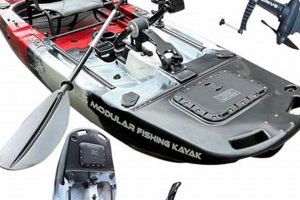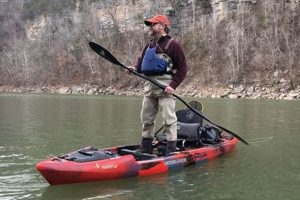This activity involves angling from a small, human-powered watercraft in the coastal waters near Rockport. It offers a unique blend of recreation and sport, allowing close contact with the marine environment while pursuing various fish species. Imagine casting a line for redfish in the shallows, or trolling for mackerel in deeper waters, all from the quiet vantage point of a kayak.
The calm, shallow-draft nature of kayaks grants access to areas inaccessible to larger vessels, opening up prime fishing grounds teeming with life. This method offers a sustainable, low-impact way to enjoy the natural bounty of Rockport’s coastal ecosystem. Historically, small boats have been used for fishing in the region, but the modern popularity of specialized fishing kayaks with their enhanced stability and gear-carrying capacity has elevated this pursuit to a new level. This increased accessibility has contributed to the growth of local economies through tourism and related industries.
The following sections delve deeper into specific aspects, including suitable kayak types, recommended fishing gear, popular target species, local regulations, and safety considerations for anglers exploring the waters around Rockport from a kayak.
Tips for Kayak Fishing in Rockport
Successful kayak angling in Rockport requires preparation and adherence to best practices. The following tips provide guidance for a safe and productive experience.
Tip 1: Choose the Right Kayak: Selecting a kayak suited to the local conditions is crucial. Longer, sit-on-top kayaks offer stability and ample storage for gear, ideal for open water and offshore fishing. Shorter, sit-in kayaks offer maneuverability, well-suited for navigating shallow creeks and protected bays.
Tip 2: Essential Gear: Pack essential safety equipment, including a personal flotation device (PFD), a whistle, and a first-aid kit. Fishing-specific gear such as rod holders, tackle boxes, and a landing net should be securely stowed. A fish finder and GPS unit can significantly enhance fishing success.
Tip 3: Understand Local Regulations: Familiarize oneself with Texas Parks and Wildlife Department regulations regarding licensing, catch limits, and permitted fishing methods. Respecting these regulations ensures the sustainability of local fish populations.
Tip 4: Check Weather Conditions: Prior to launching, check the marine forecast for wind speed, wave height, and tides. Avoid venturing out in adverse conditions, particularly strong winds or thunderstorms.
Tip 5: Plan Your Route: Map out a fishing route, considering factors such as water depth, currents, and potential hazards. Identify launch points and potential landing spots in case of unexpected changes in weather.
Tip 6: Practice Paddle Strokes: Mastering efficient paddling techniques conserves energy and allows for precise maneuvering. Practice different strokes for navigating various conditions, including wind and currents.
Tip 7: Respect Wildlife: Maintain a safe distance from marine life and avoid disturbing nesting areas. Practice catch-and-release techniques whenever possible to help conserve fish populations.
Tip 8: Inform Someone of Your Plans: Always inform someone ashore of your intended fishing location and estimated return time. This precautionary measure ensures assistance can be rendered in case of an emergency.
Adhering to these guidelines contributes significantly to a safer and more rewarding kayak fishing experience in Rockport. Careful planning and responsible angling practices ensure the continued enjoyment of this popular recreational activity.
By understanding the intricacies of kayak fishing in Rockport and applying these practical tips, anglers can confidently explore the diverse waters and abundant fishing opportunities this coastal region offers.
1. Kayak Selection
Appropriate kayak selection significantly impacts the success and safety of kayak fishing excursions in Rockport. The diverse water environments, ranging from calm bays to open coastal waters, necessitate careful consideration of kayak design and features. Stability, maneuverability, and storage capacity are key factors influencing effective angling. A stable platform is essential for casting and reeling, especially when battling larger fish. Maneuverability allows anglers to navigate shallow areas, tight creeks, and areas with dense vegetation, maximizing access to prime fishing spots. Sufficient storage capacity accommodates essential gear, including rods, tackle boxes, and safety equipment.
For example, a longer, sit-on-top kayak with a wider beam offers excellent stability and ample storage, well-suited for offshore fishing in Aransas Bay. Its design allows anglers to comfortably stand and cast, providing better leverage and visibility. Conversely, a shorter, sit-in kayak with a narrower hull excels in maneuverability, making it ideal for exploring the shallow flats and backwater areas of Copano Bay. This design allows for quicker turns and easier navigation through tight spaces, increasing access to secluded fishing holes.
Selecting the appropriate kayak type based on the intended fishing location and target species optimizes angling effectiveness and overall enjoyment. Failure to consider these factors can lead to instability, difficulty maneuvering, and limited access to desirable fishing grounds. Understanding the interplay between kayak design, water conditions, and fishing techniques contributes significantly to a successful and rewarding experience in the diverse waters surrounding Rockport.
2. Essential Gear
Appropriate gear is paramount for a successful and safe kayak fishing experience in Rockport. The unique demands of this activity necessitate specialized equipment that enhances both angling effectiveness and personal safety. Careful consideration of these essential items ensures preparedness for the diverse conditions and fishing opportunities encountered in the Rockport area.
- Personal Flotation Device (PFD)
A properly fitted PFD is non-negotiable. This vital piece of safety equipment provides buoyancy and increases survivability in the event of capsizing or unexpected immersion. Texas law requires all vessels, including kayaks, to carry one approved PFD per person on board. Choosing a comfortable, fishing-specific PFD with ample pocket storage enhances both safety and convenience.
- Paddle/Leash
A reliable paddle and leash are fundamental for kayak propulsion and control. A lightweight, appropriately sized paddle minimizes fatigue during long paddling sessions. The leash secures the paddle to the kayak, preventing loss in the event of a capsize or accidental drop. Consider a paddle with a drip guard to reduce water dripping onto the kayak and angler.
- Fishing Tackle and Equipment
Rods, reels, lines, hooks, lures, and bait tailored to target species in Rockport waters are essential. Rod holders mounted on the kayak provide secure storage and easy access while paddling or fighting fish. A tackle box organizes essential fishing gear and keeps it readily available. A landing net aids in safely retrieving hooked fish, minimizing handling time and stress on the catch.
- Safety and Navigation Equipment
Safety equipment beyond the PFD contributes significantly to a secure experience. A whistle signals for assistance in emergencies. A first-aid kit addresses minor injuries. A waterproof VHF radio allows communication with other boaters and shore-based resources. A GPS unit and chartplotter facilitate navigation, especially in unfamiliar waters or during periods of reduced visibility. A bilge pump and sponge address water accumulation in the kayak.
The careful selection and proper utilization of this essential gear contribute significantly to a successful and enjoyable kayak fishing experience in Rockport. The interplay of safety, functionality, and specialized fishing equipment allows anglers to confidently explore the diverse waters and pursue the abundant fishing opportunities found within the Rockport ecosystem.
3. Target Species
The diverse estuarine and nearshore environments around Rockport support a rich variety of fish species, making it a prime destination for kayak anglers. Understanding the prevalent target species, their habitat preferences, and seasonal availability significantly enhances fishing success. Knowledge of these factors informs tackle selection, fishing techniques, and location choices, maximizing the chances of a productive and rewarding experience.
- Redfish (Red Drum)
Redfish are a highly sought-after species in Rockport, known for their powerful fights and delicious flavor. They inhabit shallow grassy flats, oyster reefs, and channels, often feeding on crustaceans and small fish. Kayak anglers target redfish using a variety of techniques, including sight-fishing with artificial lures or presenting live bait near structure. Their accessibility in shallow waters makes them ideal for kayak pursuit.
- Speckled Trout (Spotted Seatrout)
Speckled trout are another popular target, prized for their sporting qualities and table fare. They frequent similar habitats as redfish, often found near grass beds, submerged structures, and deeper drop-offs. Kayak anglers target speckled trout using topwater lures, soft plastics, and live bait. Their preference for ambush points near structure aligns well with the stealthy approach afforded by kayaks.
- Flounder (Southern Flounder)
Flounder are a unique flatfish species found on sandy or muddy bottoms, often camouflaged against the seabed. Kayak anglers target flounder by drifting or slowly trolling along these areas, using live bait or jigs bounced along the bottom. The quiet movement of a kayak minimizes disturbance, increasing the chances of encountering these ambush predators.
- Black Drum
Black drum are a larger member of the drum family, offering a challenging fight for kayak anglers. They inhabit deeper channels, bays, and nearshore reefs, often feeding on crustaceans and shellfish. Kayak anglers target black drum using heavier tackle and baits such as crabs or shrimp fished near the bottom. While larger specimens can test the angler’s skill and equipment, the stable platform of a fishing kayak provides an advantageous angling position.
Matching fishing techniques and tackle to the specific target species and their preferred habitats greatly increases the likelihood of success in Rockport waters. The quiet approach and maneuverability of a kayak provide distinct advantages when pursuing these species, allowing anglers to access areas often inaccessible to larger boats. Understanding the nuances of each species’ behavior and habitat preferences allows anglers to refine their approach and maximize their chances of a rewarding catch.
4. Launch Locations
Launch locations play a crucial role in kayak fishing around Rockport, Texas. Strategic selection of a launch site directly influences accessibility to target fishing areas, impacts the overall fishing experience, and dictates logistical considerations such as parking and facilities. The varied coastline, encompassing both protected bays and open water areas, necessitates careful planning and consideration of launch site characteristics. Factors such as water depth, tidal currents, proximity to fishing grounds, and prevailing wind conditions contribute to efficient and productive kayak fishing excursions.
Several public boat ramps provide convenient access to Aransas Bay, Copano Bay, and the surrounding estuaries. These locations typically offer ample parking, deeper water access suitable for launching kayaks, and often feature amenities such as restrooms and fish cleaning stations. For example, the Goose Island State Park boat ramp provides direct access to Aransas Bay, known for its redfish and speckled trout populations. Alternatively, the Little Bay boat ramp offers convenient launching into the calmer waters of Little Bay, ideal for targeting flounder and black drum. In addition to established boat ramps, numerous smaller, less developed launch sites exist along the coastline. These locations may offer more secluded access to specific fishing grounds, but often lack amenities and require careful assessment of water depth and potential hazards. For experienced kayak anglers seeking solitude, paddling directly from the shoreline near their chosen fishing spot may be feasible. However, this approach requires careful consideration of tide levels and potential obstacles.
Effective launch site selection optimizes fishing time and minimizes logistical challenges. Careful assessment of launch location characteristics, coupled with knowledge of target species habitat preferences and prevailing environmental conditions, contributes significantly to successful kayak fishing in the Rockport area. Prioritizing launch sites that align with the angler’s skill level, desired fishing experience, and target species enhances the overall enjoyment and productivity of each outing. Neglecting these considerations can lead to difficulties launching and retrieving the kayak, extended paddling times to reach fishing areas, and potentially hazardous situations.
5. Local Regulations
Adherence to local regulations is essential for responsible and sustainable kayak fishing in Rockport. These regulations, established by the Texas Parks and Wildlife Department (TPWD), govern aspects such as licensing requirements, catch limits, size restrictions, and permitted fishing methods. Understanding and complying with these rules ensures the conservation of fish populations, protects the local ecosystem, and maintains the quality of the recreational fishing experience for all. Ignoring these regulations can result in fines, legal penalties, and contribute to the depletion of valuable resources.
Specific regulations relevant to kayak fishing in Rockport include possessing a valid Texas fishing license with a saltwater endorsement. License exemptions exist for certain individuals, such as residents born before January 1, 1931, and children under 17. Catch limits and size restrictions vary depending on the species. For example, redfish have a slot limit, allowing anglers to keep fish within a specific size range, protecting both juvenile and breeding-sized individuals. Certain areas may be designated as “no-take” zones, prohibiting any fishing activity to preserve critical habitats or spawning grounds. Permitted fishing methods also vary; some areas may restrict the use of certain gear types or fishing techniques to minimize environmental impact or protect specific species.
Practical application of this understanding involves researching and familiarizing oneself with current regulations before each fishing trip. The TPWD website provides comprehensive information regarding licensing, catch limits, and area-specific regulations. Consulting local bait shops or fishing guides provides additional insights into current conditions and applicable rules. Responsible anglers prioritize compliance with local regulations, contributing to the long-term health of the Rockport fishery and ensuring continued access to this valuable resource for future generations. This proactive approach safeguards the delicate balance of the coastal ecosystem and fosters a sustainable recreational fishing environment.
6. Safety Procedures
Safeguarding well-being while kayak fishing in Rockport requires meticulous attention to established safety procedures. The inherent risks associated with open water activities, combined with the specialized nature of kayak fishing, necessitate a proactive and informed approach. Prioritizing safety ensures not only a positive angling experience but also mitigates potential hazards and promotes responsible enjoyment of the Rockport coastal environment.
- Personal Flotation Devices (PFDs)
Wearing a properly fitted PFD is paramount. PFDs provide essential buoyancy in the event of capsizing or accidental immersion, significantly increasing survival chances. Selecting a comfortable, fishing-specific PFD with ample pocket storage enhances both safety and practicality. Regularly inspecting PFDs for wear and tear ensures their continued effectiveness. Texas law mandates PFD availability on all vessels, including kayaks.
- Weather Awareness and Monitoring
Checking marine weather forecasts before embarking on a kayak fishing trip is crucial. Wind speed, wave height, and potential storms significantly impact safety on the water. Avoiding adverse conditions, particularly strong winds or lightning storms, prevents hazardous situations. Monitoring weather conditions throughout the fishing trip allows for timely adjustments to plans and ensures preparedness for unexpected changes.
- Communication and Emergency Preparedness
Carrying a waterproof VHF radio facilitates communication with other boaters and shore-based resources in case of emergencies. Informing someone ashore of the intended fishing location and estimated return time provides an additional layer of safety. A fully charged mobile phone in a waterproof case allows for emergency contact if within cellular range. Familiarization with basic first aid and CPR techniques further enhances preparedness for unexpected situations.
- Navigation and Awareness of Surroundings
Carrying a nautical chart or GPS unit aids in navigation, particularly in unfamiliar waters or during periods of reduced visibility. Awareness of potential hazards such as shallow areas, submerged obstacles, and changing tides is crucial for safe navigation. Maintaining a safe distance from other vessels and respecting marked channels prevents collisions and ensures smooth transit within the Rockport waterways.
Integrating these safety procedures into every kayak fishing excursion in Rockport fosters a culture of preparedness and responsible angling. A proactive approach to safety minimizes risks, enhances the overall fishing experience, and ensures the continued enjoyment of this popular recreational activity. Neglecting these precautions can jeopardize personal safety and detract from the natural beauty and abundant fishing opportunities offered by the Rockport coastal environment.
7. Tidal Influences
Tidal fluctuations exert a significant influence on kayak fishing success in Rockport. Understanding tidal cycles, currents, and their impact on fish behavior is crucial for optimizing angling strategies. Tides govern water depth, current strength, and the movement of baitfish, directly affecting the location and feeding patterns of target species. Anglers who comprehend these tidal influences can effectively predict prime fishing times and locations, significantly enhancing their chances of a successful catch.
Incoming tides, for example, inundate shallow flats and marshes, creating feeding opportunities for redfish and speckled trout as they pursue baitfish swept in by the rising water. Conversely, outgoing tides concentrate fish in channels and deeper pools as water recedes from the flats. These tidal movements create predictable ambush points and feeding zones, allowing kayak anglers to position themselves strategically. Strong currents associated with peak tidal flows can present challenges for kayak anglers, requiring careful paddle management and anchoring techniques. However, these currents also transport nutrients and baitfish, attracting larger predatory species. Knowledge of these tidal dynamics informs lure selection, retrieval techniques, and drift fishing strategies.
Effective integration of tidal knowledge into kayak fishing practices in Rockport necessitates consulting tide charts and local current predictions. Awareness of tidal stages allows anglers to plan their fishing trips to coincide with optimal conditions for their target species. This understanding, combined with knowledge of local bathymetry and fish behavior, enhances angling effectiveness and promotes a deeper appreciation for the interconnectedness of the coastal ecosystem. Failure to consider tidal influences can result in unproductive fishing trips, missed opportunities, and potential navigation challenges. By incorporating tidal awareness into pre-trip planning and on-the-water decision-making, kayak anglers significantly improve their chances of success in the dynamic waters around Rockport.
Frequently Asked Questions
This section addresses common inquiries regarding kayak fishing in Rockport, Texas, providing concise and informative responses to facilitate a better understanding of this popular activity.
Question 1: What type of kayak is best suited for fishing in Rockport?
Kayak selection depends on the intended fishing location and target species. Stable, sit-on-top kayaks are generally preferred for offshore fishing in Aransas Bay, while shorter, more maneuverable kayaks are better suited for navigating shallow flats and backwater areas. Specialized fishing kayaks often feature built-in rod holders, storage compartments, and other angler-specific amenities.
Question 2: What essential gear is required for kayak fishing in Rockport?
Essential gear includes a properly fitted personal flotation device (PFD), a paddle with a leash, appropriate fishing rods and reels, tackle suited to target species, a first-aid kit, a whistle, and navigation tools such as a GPS unit or chart. A fish finder, anchor, and landing net are also recommended.
Question 3: Where can kayaks be launched in Rockport?
Numerous public boat ramps provide access to the surrounding waters, including those at Goose Island State Park and Little Bay. Less developed launch sites also exist along the coastline, but may require careful assessment of water depth and potential hazards.
Question 4: What are the common target species for kayak anglers in Rockport?
Popular target species include redfish, speckled trout, flounder, and black drum. The specific species available depends on the season, location, and prevailing environmental conditions.
Question 5: Are there specific fishing regulations that apply to kayak anglers in Rockport?
All anglers, including those fishing from kayaks, must possess a valid Texas fishing license with a saltwater endorsement. Catch limits, size restrictions, and permitted fishing methods vary by species and location. Consulting the Texas Parks and Wildlife Department website provides detailed information on current regulations.
Question 6: What safety precautions should be taken when kayak fishing in Rockport?
Prioritizing safety includes always wearing a PFD, checking marine weather forecasts before launching, informing someone of fishing plans, carrying communication devices such as a VHF radio, and being aware of potential hazards such as changing tides and boat traffic. Knowledge of basic first aid and CPR is also recommended.
Understanding these common inquiries and their corresponding answers facilitates a more informed and enjoyable kayak fishing experience in Rockport. Thorough preparation and responsible angling practices contribute to both personal safety and the preservation of this valuable coastal resource.
For further information and detailed guidance, consult local fishing guides, bait shops, or the Texas Parks and Wildlife Department.
Kayak Fishing Rockport
This exploration of kayak fishing in Rockport has highlighted the unique blend of angling skill, environmental awareness, and respect for local regulations required for a successful and sustainable experience. From kayak selection and essential gear to target species and launch locations, careful consideration of each element contributes to a rewarding outing. Understanding tidal influences and adhering to established safety procedures ensures both angler well-being and the preservation of this valuable coastal resource.
The Rockport area offers exceptional opportunities for kayak anglers to connect with the natural environment while pursuing a diverse range of fish species. Continued appreciation for the delicate balance of this ecosystem, coupled with responsible angling practices, will ensure the longevity of this rewarding recreational activity for generations to come. Through informed decision-making and a commitment to conservation, the future of kayak fishing in Rockport remains promising.






